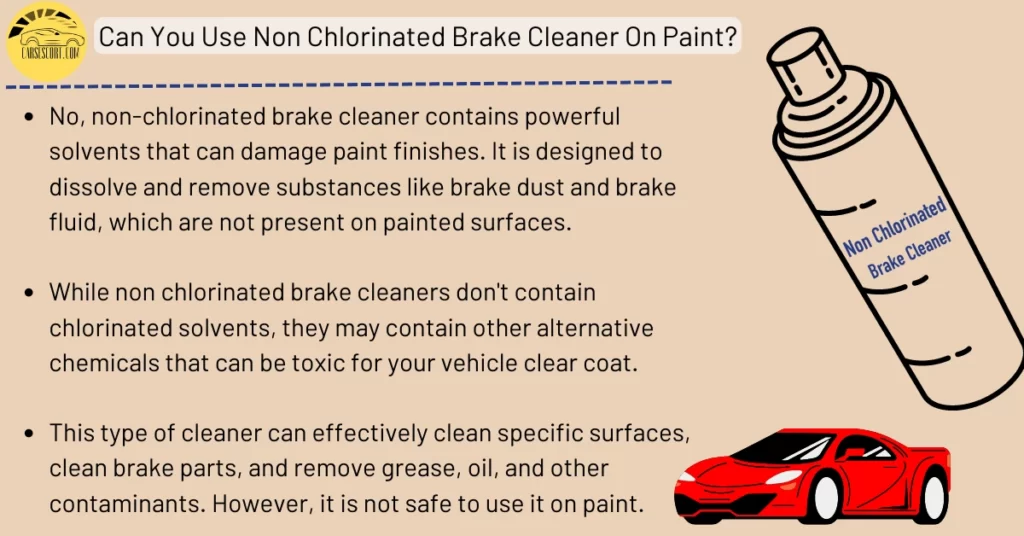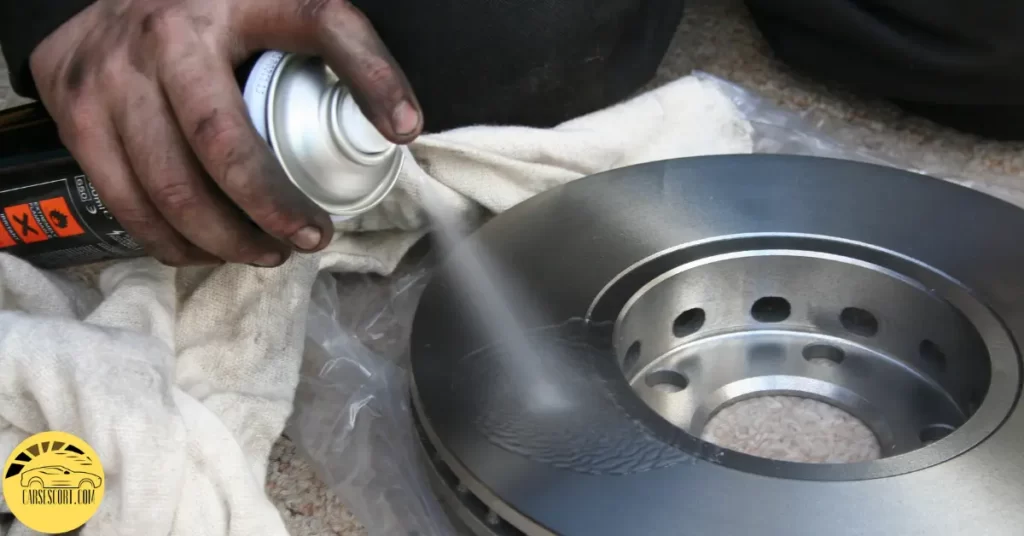Brake cleaner is a dependable ally in automotive maintenance, swiftly tackling grease, grime, and debris. Yet, discussions surrounding using non-chlorinated brake cleaner on paint often give rise to a flurry of misconceptions and conflicting advice.
- Non chlorinated brake cleaner is not safe to use on car paint because the acetone and other solvents can strip away the protective coatings, fade the color, or cause the paint to peel.
- While non chlorinated brake cleaners don’t contain chlorinated solvents, they may contain other alternative chemicals that can be toxic for your vehicle clear coat.
- This type of cleaner can effectively clean specific surfaces, clean brake parts, and remove grease, oil, and other contaminants. However, it is not safe to use it on paint.
As a car enthusiast or an individual concerned about the well-being of your vehicle’s exterior, it is crucial to separate fact from fiction and understand the potential ramifications of using chlorinated and non chlorinated brake cleaners on painted surfaces.
Can You Use Non Chlorinated Brake Cleaner On Paint?
No, non-chlorinated brake cleaner contains powerful solvents that can damage paint finishes. It is designed to dissolve and remove substances like brake dust and brake fluid, which are not present on painted surfaces.
The cleaner can be effective for cleaning specific surfaces to clean brake parts and remove grease, oil, and other contaminants. However, it is not recommended to use it on car paint.
Using non-chlorinated cleaner on car paint surfaces may strip away the protective coatings, fade the color, or cause the car’s caot to peel.
If you have accidentally used non-chlorinated brake solution, it is essential to rinse the area thoroughly with water as soon as possible to minimize potential damage.
If the car clear coat may appears to be affected, it may be necessary to seek professional assistance from a painter or automotive specialist to repair or restore the damaged area.
If you need to clean paint, using products specifically designed for that purpose is best. Mild soap and water, automotive detailing products, or safe cleaners are usually the safest options.

Try Our Recommendation:
Cons of Using Non Chlorinated Brake Cleaner On Paint
1) Paint Damage
Non-chlorinated brake cleaners can cause damage to painted surfaces. It may strip off the paint or leave behind stains or discoloration.
2) Material Compatibility
Certain materials, such as rubber or plastic surfaces, may not be compatible with non-chlorinated cleaners. It can cause these materials to degrade, crack, or become discolored.
3) Toxicity
While non-chlorinated cleaners are generally considered less toxic than their chlorinated counterparts, they still contain chemicals that can harm humans and the environment if not handled properly. Prolonged exposure or inhalation of the fumes can have adverse health effects.
4) Flammability
Non-chlorinated cleaners are highly flammable. Their use near open flames, sparks, or hot surfaces can pose a fire hazard. Using them in well-ventilated areas and taking necessary precautions to avoid ignition sources is important.
5) Residue
It may leave behind a residue after use and require additional cleaning to ensure a clean surface.
6) Environmental Impact
Although non-chlorinated cleaners are considered more environmentally friendly than their chlorinated counterparts, they still contain volatile organic compounds (VOCs) that contribute to air pollution and can harm aquatic life if disposed of improperly.
7) Limited Effectiveness
It may be less effective at removing certain types of dust, grime, or oil than chlorinated ones, resulting in incomplete cleaning or additional cleaning steps.
Chlorinated vs. Non Chlorinated Brake Cleaner
Chlorinated and non-chlorinated brake cleaners are two cleaning solvents used to clean brake system parts. Their main difference lies in their chemical composition and potential environmental impact.
What does chlorinated mean in brake cleaner?
Chlorinated Brake Cleaner
Chlorinated brake cleaners contain chemicals such as perchloroethylene (also known as tetrachloroethylene) or trichloroethylene. These chemicals effectively remove grease, oil stains, and dust from brake components.
However, they are considered hazardous to the environment and human health.
Pros
- Powerful degreasing properties.
- Effective in removing harsh brake residues.
- Fast evaporating, leaving little to no residue.
Cons
- Environmental and health concerns.
- Harmful if inhaled or ingested.
- Damaging to certain plastics and rubber components.
Non-Chlorinated Brake Cleaner
Non-chlorinated cleaners are formulated with alternative chemicals, such as acetone, ethanol, or isopropyl alcohol. They are designed to provide effective cleaning without the use of chlorinated solvents.
Pros
- Safer for the environment and human health.
- It can be used on a wide range of brake components.
- Less likely to cause damage to plastics and rubber parts.
Cons
- It may require more effort to remove harsh residues.
- Some non-chlorinated cleaners may have slower evaporation rates, leaving behind residue if not properly wiped off.
You May Also Like To Read:
Is Brake Cleaner Safe On Paint?
Brake cleaner is not safe to use on painted surfaces. Brake cleaner is a strong solvent designed to remove grease, oil stains, brake fluid, power steering fluid and other contaminants from metal brake parts.
It is formulated to be highly effective at dissolving these substances, but it can also damage certain types of paint surfaces.

How To Use Brake Cleaner?
When using brake cleaner, following the manufacturer’s instructions and taking necessary safety precautions is important. Here is a general guideline for using solution:
- Ensure the vehicle is in a well-ventilated area or outdoors.
- Use appropriate personal protective equipment, such as gloves and eye protection, to avoid contact with the skin or eyes.
- Shake the cleaner can well before use.
- Spray the cleaner directly onto the parts that need cleaning, such as brake calipers, rotors, or other metal components.
- Allow the cleaner to penetrate and dissolve dirt, grime, or dust for a few minutes.
- Use a clean cloth or a brush to wipe away the dissolved residue.
- Repeat the process if necessary, especially for heavily soiled areas.
- Once the cleaning is complete, allow the parts to dry completely before reassembling or applying lubricants or other products.
- Remember to follow instructions provided by the manufacturer for the best results and safety precautions.

Can I Use Brake Cleaner To Remove Brake Dust From My Wheels?
No, do not use brake cleaner on your vehicle tires because it can cause damage to the wheels. Alternatively, you can use brake dust cleaner or brake dust remover to do the job.
Brake dust is a common byproduct of brake pad wear and can accumulate on the wheels, giving them a dirty and unsightly appearance. To remove dust using brake dust cleaner, follow these steps:
- Ensure the wheels are cool to the touch before cleaning.
- Spray cleaner directly onto the wheel surface, focusing on the areas with visible dust.
- Allow the cleaner to dwell for a few moments to dissolve the dust.
- Use a soft bristle or wheel brush to agitate the solution and loosen the dust.
- Rinse the wheel thoroughly with water to remove the dissolved residue and debris.
- Dry the wheels with a clean microfiber cloth to prevent water spots or streaks.
- Repeat the process for each wheel until they are clean and free from dust.
Some cleaners may contain harsh chemicals that could damage certain wheel finishes or coatings.
Therefore, it’s recommended to test the brake cleaner on a small, inconspicuous area of the wheel first and observe any adverse reactions before proceeding with the entire wheel.
FAQ
Can I clean other parts with brake cleaner?
Yes, brake cleaner can be used to clean various parts other than painted surfaces. Its strong solvent properties also make it effective for cleaning other automotive parts.
Brake cleaners can clean metal parts, such as engine components, carburetors, throttle bodies, and other mechanical parts. It can help dissolve and remove built-up grime, dirt, and oily residues from these surfaces.
Does brake cleaner harm brake pads and shoe linings?
Brake cleaner, when used as directed, typically does not harm brake pads and shoe linings. Brake cleaner is designed to effectively remove grease, oil, dirt, and dust from braking components.
However, prolonged or excessive use of brake cleaner may cause damage to the brake pads and shoe linings, as it can potentially strip away the lubricants and resins that are important for their proper functioning.
Is It OK To Get Brake Cleaner On Pads?
It is generally not recommended to spray or soak cleaner on brake pads directly. Brake pads are made of friction materials designed to provide optimal braking performance.
Brake cleaners can remove the protective lubricants and resins on the pads, which may compromise their effectiveness.
If the brake cleaner accidentally comes in contact with the brake pads, it is advisable to rinse the pads thoroughly with water to remove any residue and then allow them to dry completely before reinstalling.
Is brake cleaner safe on rubber?
Brake cleaner, in general, is not recommended for use on rubber components. The chemicals in cleaner can degrade or damage rubber, causing it to become brittle, crack, or deteriorate over time.
If you need to clean rubber parts, such as seals, hoses, or gaskets, it’s best to use products specifically formulated for rubber cleaning.
My Final Thoughts
Using Non-Chlorinated Brake Cleaner on Paint: Non-chlorinated brake cleaner can damage your car’s clear coat, causing it to strip and peel. Brake cleaner is a powerful solvent specifically formulated to eliminate grease, oil stains, brake fluid, power steering fluid, and various contaminants from metal components. However, it can adversely affect the vehicle’s plastic and rubber parts, leading to potential damage.
Affiliate Disclosure: Cars Escort is a participant in the Amazon Services LLC Associates Program. As an Amazon Associate, we earn from qualifying purchases made through affiliate links on our site. Read Our Disclaimer .

